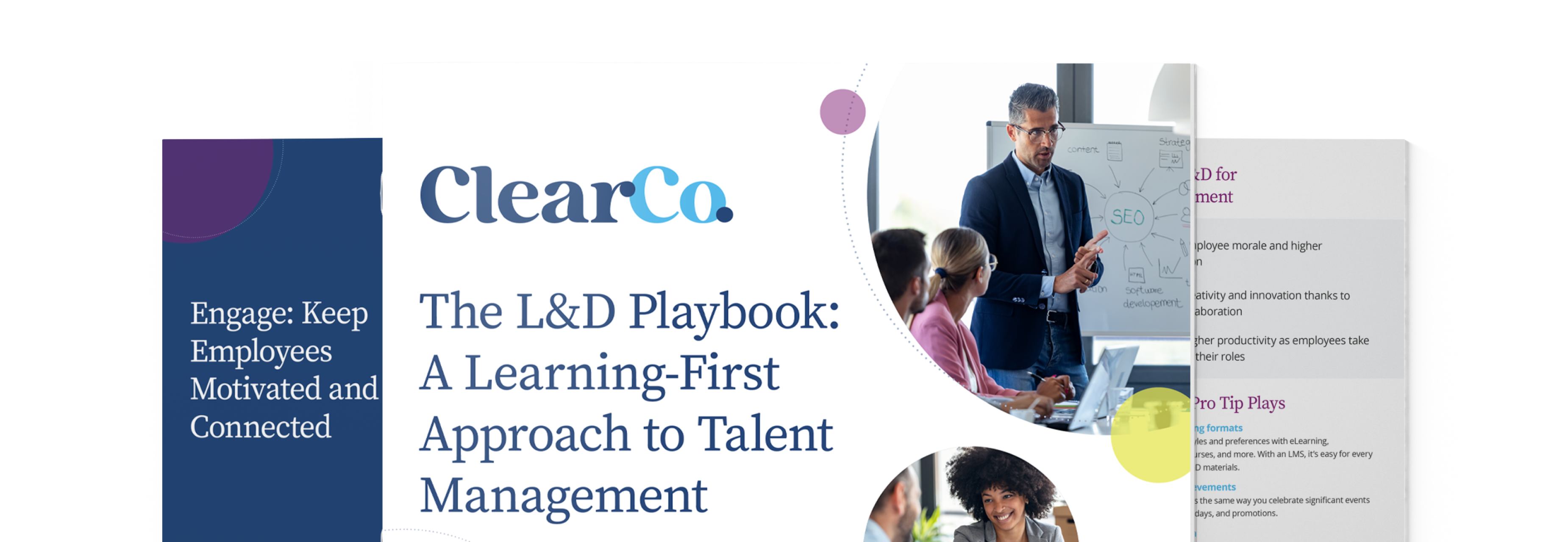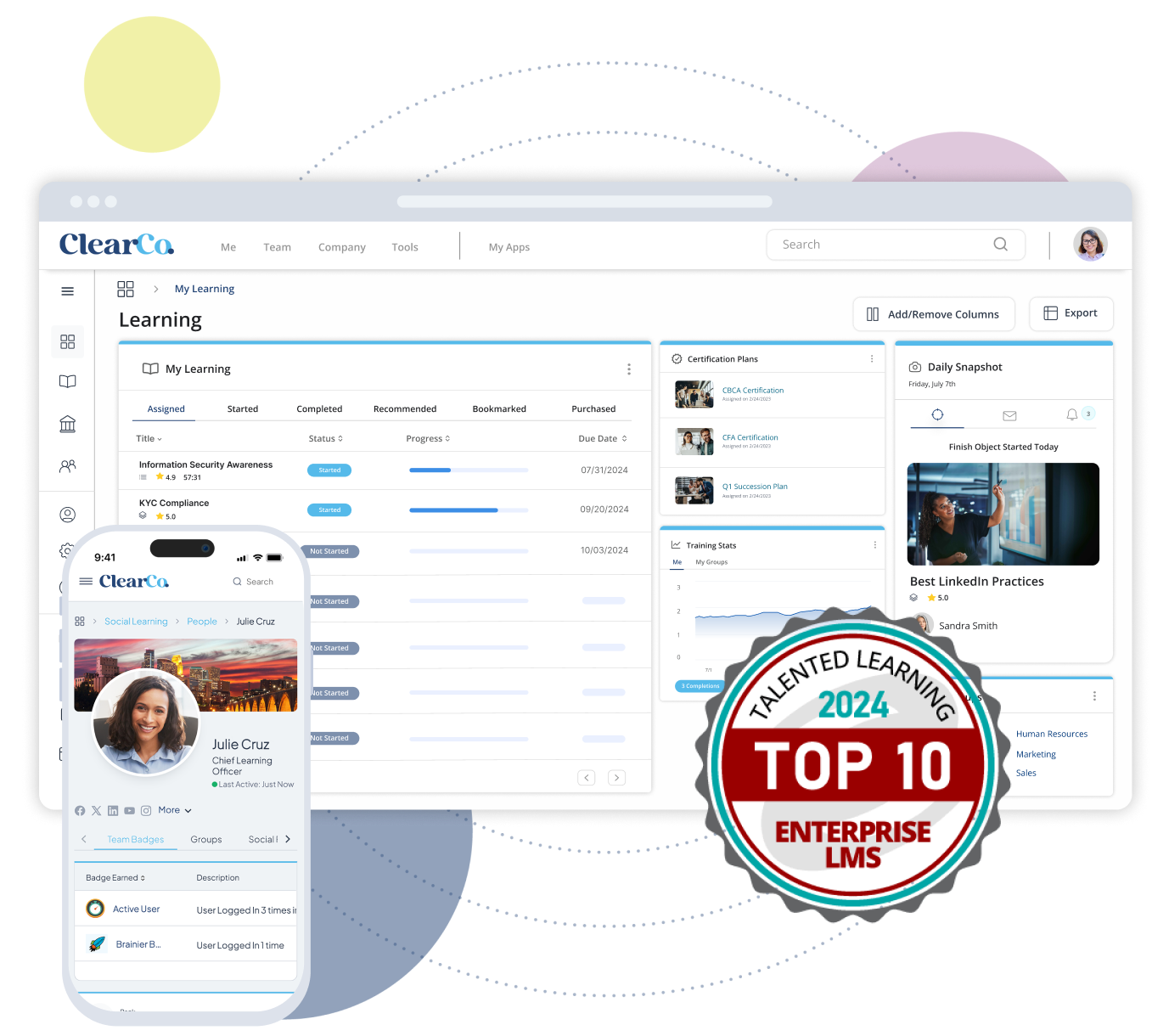Now is the time to help your workforce grow — and we’re not talking about headcount. The importance of employee training and development can’t be overstated in today’s “skills economy,” where current skills are quickly becoming outdated. 49% of learning and development (L&D) professionals said their company is in a “skills crisis,” worried that their employees are not equipped with the skills they need to achieve business goals.
Fortunately, your people are eager to learn new ones. L&D opportunities at work are a top factor in employee retention and engagement, and they help your business become and stay competitive. Here’s why training and development programs are the right response:
- Frontline workers said if they received better career support and training, they’d stay at their jobs significantly longer. Two-thirds said they’d stay an additional six years, while 44% said they’d stay another decade.
- 100% of businesses that prioritize L&D — ”career development champions” — are achieving positive results, including increased internal mobility and new skills acquisition.
- 84% of employees agreed, “Learning adds purpose to my work.” Feeling a sense of purpose at work is essential for employee engagement and retention.
Investing in your people drives growth, plain and simple. But not all training programs are created equal. You can’t just buy a learning management system (LMS) or another eLearning platform, plug it in, and let it run. You need a complete learning and development strategy for the entire employee journey, from onboarding until their last promotion.
If you’re ready to transform training and development into a key driver of success, you’re in the right place. Keep reading, and we’ll explore the importance of training and development, how it impacts both your people and the business, and how your organization can get it right.
What Is Employee Training and Development?
We’ll quote ourselves on this one — from our in-depth article on the topic:
Employee training and development refers to the ways companies teach internal processes and procedures and maintain, improve, and assess employees’ skills and knowledge. Training is about teaching employees specific skills or protocols in a set period of time, usually several hours or days, while development refers to longer-term skills growth. Training is commonly grouped with employee learning and development, or L&D.
Both training and development are important aspects of developing your people and should have a place in your program. The goal of employee training is consistency, whether that means maintaining a license or ensuring every new hire learns the same processes. L&D is aimed at enabling employees’ growth — helping increase their productivity, learn new skills, and advance in their careers.
Read our post, A Guide to Employee Training & Development, to dig even deeper.
Why Is Training and Development Important in the Workplace?
We’re squarely in the age of artificial intelligence (AI), and the need for AI skills is not a passing learning and development trend. Its rapid advancement is one of the main contributors to the skills gaps we’re seeing today. As technology advances, your employees’ knowledge and skills must, too.
The career development champions we mentioned are 32% more likely than other businesses to be starting AI training programs this year. They’re anticipating the ways their business will evolve and preparing their employees for the future. By focusing on the future, career development champions also become a choice employer for job seekers and signal to current employees that they can expect long-term growth.
Investing in training and development is what sets great organizations apart. Giving your team the skills and confidence they need means you’re building a workforce that’s ready to innovate, adapt, and tackle what challenge comes next. L&D programs don’t just attract great talent, they help you keep it, creating a culture of continuous improvement.
Helping your employees level up creates an environment where growth is the norm and success becomes a shared goal. With the right training and development opportunities, you can turn potential into performance and watch them deliver results that exceed expectations.
Employee Training At Every Stage
Make L&D a priority throughout the employee journey. Find out how:
Download The L&D Playbook: A Learning-First Approach to Talent Management.
5 Benefits of Training and Development
To cover all of the benefits of training your employees frequently, we’d need to write a book. These are just a few examples of how your workplace can change when you have a strong L&D program.
- Retain More Employees: If employees don’t feel like they’re growing, they’re less likely to stick around. Career growth and learning opportunities are now expected, with 84% of workers saying their employer should provide the training they need for their roles. Investing in your people shows them you’re invested in their long-term success, giving them less reason to look elsewhere.
- Promote Leaders Internally: Who knows your organization better than the people who are already in it? Training employees for leadership roles saves you the time and cost of hiring externally, and it gives your organization the benefit of leaders who already understand your values and goals. Internal promotions build trust and show your employees that their hard work can truly pay off.
- Get More Done, Faster: Did you know that 60% of employees who recently learned a new skill said they did so to get better at their jobs? Your people want to work faster and more efficiently, too. With L&D, they can adapt to changes without missing a beat, whether they need to pivot mid-project, follow new processes, or adjust their goals.
- Encourage Creativity: The more you practice anything, the better you’ll get at it, and that applies to L&D as well. Continuous learning is like a gym for the brain. When employees are constantly sharpening their skills and expanding their knowledge, they’re better equipped to think outside the box. Innovation often comes from teams that have the confidence and expertise to try new things and solve tricky problems, and that sparks the kind of creative solutions that will set your business apart from competitors.
- Foster Morale and Engagement: An empowered team is an engaged team. When employees feel valued and supported through learning opportunities, their energy, loyalty, and passion for their work skyrocket. It’s the difference between someone doing their job and someone genuinely excited to contribute to your company’s success. Strong morale translates to better collaboration, higher productivity, and a workplace people actually enjoy being part of.
Training and development isn’t just a strategy. It’s how you build a stronger, more innovative team ready to take on whatever’s next.
5 Types of Training and Development
There are different types of professional development and training that might work for your employees depending on lots of factors — the industry you’re in, the size of your business, specific roles, etc. Some types of training sessions are aimed at new hires, while others are for more seasoned employees. You might offer in-person and online training options; you might create a path for employees who want to grow their leadership skills; or your employees might engage most with the microlearning courses available in your LMS.
Whatever way you design your L&D program, the most effective training and development programs cater to various needs within the organization. Select the right type of training to ensure your employees thrive individually in their roles and contribute to the company's overall success.
Here’s a roundup of five essential types of training every workplace should prioritize.
1. Onboarding Training
During onboarding, you’re not just giving employees company handbooks and helping set up their new laptops. Your new hires are still at high risk of turnover — 20% of it happens in the first 45 days on the job. Onboarding training should focus on immersing new hires into company culture, clarifying their job duties and role expectations, and establishing relationships with colleagues.
An excellent onboarding experience is your chance to harness new hires’ high engagement and set them up for success and long-term retention.
2. Technical Skills Training
Technical skills training focuses on the specific tools or techniques your workforce uses daily. Whether it’s mastering a new software platform, leveraging AI, or operating a new piece of machinery, technical training ensures your employees have the skills and abilities required to deliver high-quality work.
It’s not just about getting the job done — ongoing training shows employees they matter. When you invest in keeping their skills sharp, you’re also investing in their confidence and motivation. And on top of that, employees expect this level of support from their employers.
But there’s a clear disconnect. While 65% of C-suite executives believe their workforce is very satisfied with learning and development opportunities, only 32% of employees feel the same. That gap won’t close itself. Providing consistent, relevant technical skills training can bridge it, ensuring your team feels fully supported and set up for success.
Keep your people up to speed so they can keep your business moving forward.
3. Leadership Development Training
Skip out on shaping future leaders, and you risk getting left behind — 71% of companies offer leadership training. In spite of that figure, just 20% of companies are confident that they have strong future leaders among their employees. Is your org in the majority for one of these statistics, or worse, both?
Focusing on leadership development helps you prepare employees to take charge and make critical decisions, steer their teams, and communicate effectively. Leadership training equips potential leaders with tools for fostering a positive and productive workplace environment, like conflict resolution, public speaking, and adaptability.
Leadership development is a long-term strategy. When you cultivate talent internally, you build a bench of first-string leaders who are ready to step up when current leaders resign or retire. That’s how you avoid scrambling to fill important roles and build a stable workforce that can weather change and uncertainty.
Developing leaders also strengthens employee loyalty by showing them they can have a future within your organization. Motivated, skilled leaders guide their teams more effectively and can inspire innovation, foster collaboration, and drive growth.
Leadership development sets the foundation for a thriving, resilient workplace full of confident employees and cohesive teams.
4. Soft Skills Training
Technical know-how is great, but what about teamwork or customer communication? Soft skills like empathy, adaptability, and problem-solving are crucial for interactions both within the team and with clients. Employees who excel in soft skills build stronger relationships, resolve conflicts more effectively, and contribute to a more collaborative workplace culture. After all, nobody likes to work with brilliant jerks.
5. Compliance Training
Every organization has to play by the rules of its locale and offer required training, or risk violations and penalties. Compliance training ensures your employees understand and follow legal requirements, company policies, and safety guidelines. From anti-harassment laws to cybersecurity protocols, required training helps protect your company from fines, lawsuits, and other mistakes that can damage its reputation. It also promotes a safe and ethical workplace.
Each of these different types of training serves a unique purpose. Using a variety of training methods helps employees grow both in their roles and as holistic contributors to the business. It also helps you ensure your workforce is skilled, motivated, and contributing to company goals.
Invest in employee training to turn your workplace into a powerhouse of innovation, collaboration, and compliance.
Investing in L&D Is Non-Negotiable
Don’t get left behind because of skills gaps. Join the future-ready organizations that are putting L&D first. A strong training and development strategy empowers your employees with the skills they need not just to keep pace but to lead the way. The rewards are clear: higher engagement, better retention, and a culture of innovation that drives lasting success.
Investing in your people today is a smart move for your business — and it’s the key to unlocking their best work and shaping a more agile, competitive future.
Start building the team that will take your organization to the next level when you use an LMS for training and development.



